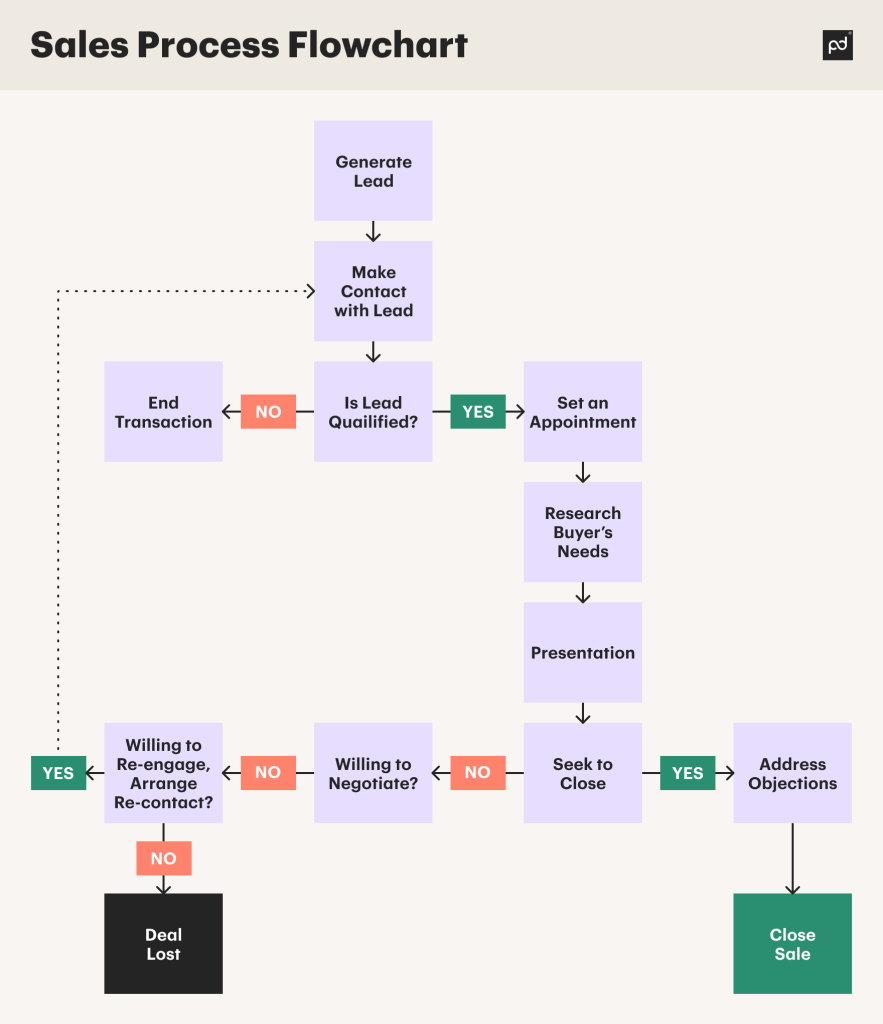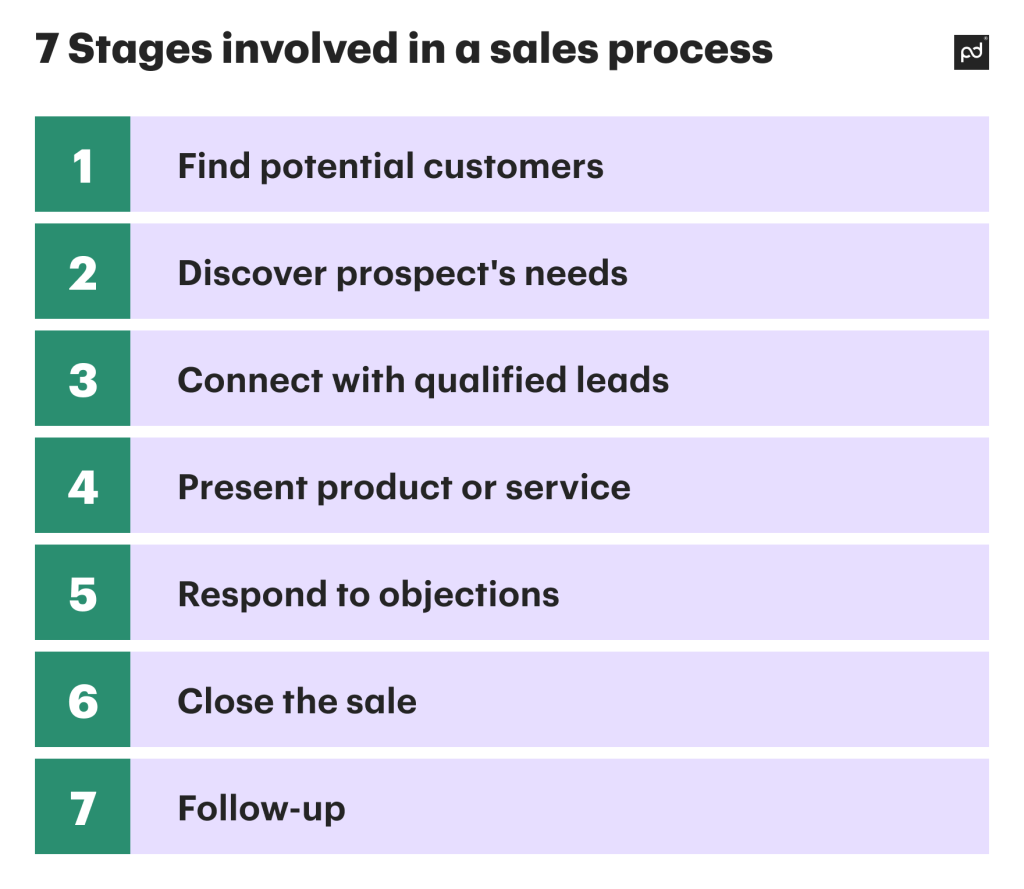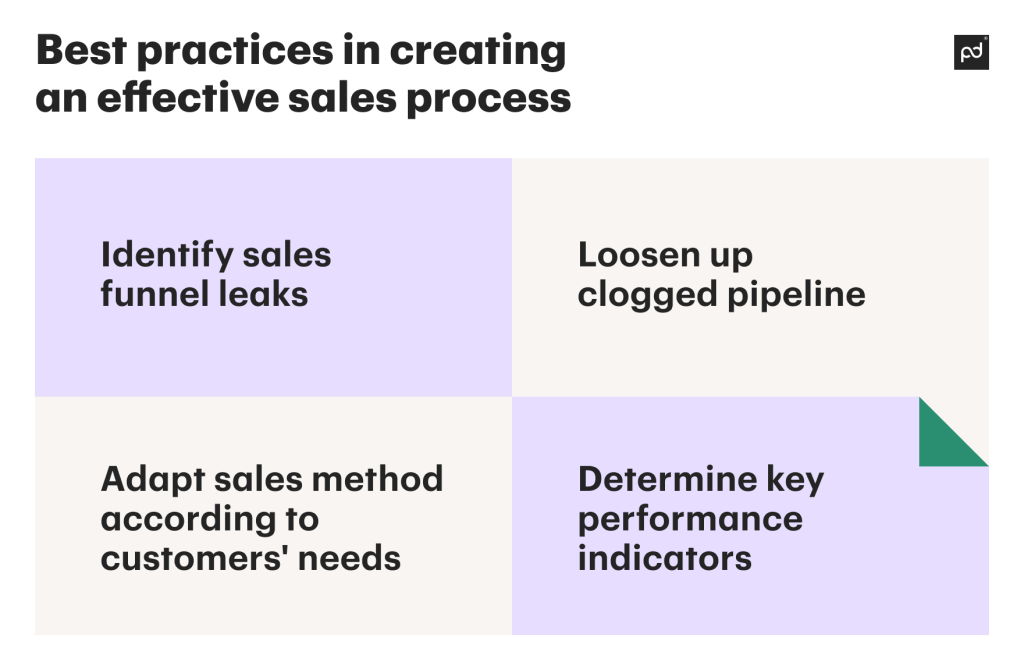Many that work in sales choose the field because of the flexibility and edge-of-your-seat experience that implementing a sales strategy involves.
Salespeople quickly adapt to consumer needs and switch up tactics whenever necessary.
While this is a good thing, it doesn’t mean your sales cycle should be completely unstructured, without any roadmap.
What is a sales workflow?
A sales workflow is a sequence of necessary processes that your team can follow to complete a sale.
It’s a structure of steps that help lead a customer further down the funnel in the most streamlined way possible.
An effective sales workflow helps improve your conversion rates, shorten the sales cycle, and increase total revenue from sales.
Sales workflows provide flexible and adaptable roadmaps that can be continually improved to keep up with evolving consumer needs and preferences.
Wondering how to streamline the sales process?
There’s simply no better way than using and refining a sales workflow, and a sales process flowchart is a visualization that can help.
How can a business benefit from a good sales process flowchart?

A sales process flowchart is an easy way to add structure to your workflow.
This visual aid gives every member of your sales team a big-picture view of the entire selling process.
Links or arrows can guide each team member on what to do next, depending on how the customer is responding.
More qualified leads
A sales flowchart helps ensure every sales associate is following the established qualifying process.
The qualification process is a critical step after prospecting is completed.
Pitching a sale is the most time-consuming part of the sales process.
This is because, if done right, any potential customer that has made it to this stage of the process has a genuine interest and intent to buy.
You don’t want to waste your team’s time or, indeed, the customer’s.
A sales workflow roadmap will help reinforce lead qualification as a filter. Don’t worry if this means a larger percentage of customers don’t make it past this point.
That just means your team will have more time for research and prospecting—and they’ll have more qualified leads in the long run.
Improved customer experience
Whether B2C or B2B, different customers will have different needs and expectations.
A sales process flowchart enables you to cater every step to each individual customer or client.
With flexible steps mapped out along the way, your team will be able to give potential buyers the time they need.
Or they’ll be able to hasten the sale with a streamlined buying process. The main point is that each potential transaction will be given the attention and flexibility it requires.
The result is an improved customer experience overall. And that can only mean one thing, more revenue and growth for your business.
More accurate sales forecasting
Breaking down your workflow into a map of processes helps your managers better identify what’s working and what’s failing.
Win rates and conversion percentages can be extrapolated for every bridge or step in the sales workflow.
Greater granularity can give your team better insights through much more accurate sales forecasting.
When connected to tools like your CRM and other solutions, these numbers can be even more powerful at guiding sales operations.
Enhanced sales techniques
When you can quantify each step of a sales workflow, it means you can maximize what’s boosting sales and cut out what’s hindering customer conversion.
Today’s consumer is continually evolving their wants and behavior.
A sales process workflow enables management to seamlessly alter and improve sales processes to keep up with these changes.
The addition of statistics like win rate allows for experimentation and improvement in real-time.
With a well-defined map, each step should be measurable and repeatable.
Your team can test out the newest cutting-edge sales techniques, thereby accelerating your sales process.
Clearer milestones
With all the possible process routes clear as day, each member of your department will know the milestones involved.
Prospectors will know when to move on to qualification or when to pass on a buyer to pitching specialists.
Flowchart milestones help everyone better work together as a team with one overarching goal.
This means your sales managers can spend less time micromanaging and more time strategizing.
Understanding sales process stages, elements, and best practices
The concept of sales is old as time.
Despite how rapidly technology and lifestyles are changing, the main steps remain the same. However, it’s how you implement them that’s changing.
Let’s take a look at each stage of the overall sales process.
7 Stages involved in a sales process

1. Find potential customers
The first step to making a sale is prospecting or lead generation.
The process you outline for prospecting sets up how the rest of your sales workflow will operate. So it’s important to curate viable and effective prospecting methods for your team.
It’s best practice to start with your due diligence. This means creating buyer personas or profiling your ideal customers.
Once your customer profiles have been created, you can decide how to prioritize the prospecting channels available.
For instance, if you’re working in B2B, you may decide that LinkedIn is the top source for finding new sales leads.
Of course, you’d also combine this with other proven methods, such as email lists and cold-calling potential clients.
2. Discover prospects’ needs
A sales workflow should always direct team members to research as much as necessary.
This discovery process doesn’t end during prospecting. Once a potential new buyer has been located, it’s time for the seller to learn all they can about the new lead.
This means gathering any information relevant to the sale, including:
- Client history and reputation within their markets and industry
- Potential client objections and concerns
- The most pertinent information on your products or services for this client
- Past leads and sales notes to garner the best tactics and information to use.
An important component that’s often overlooked is qualitative research.
It’s easy for us to focus on numbers, but non-quantifiable data is also important when determining buyer profiles. So it’s important that you know how to build qualitative research into your sales process.
It’s important to run through this discovery process as it helps with lead qualification when moving on to the next stage.
If something doesn’t check out during the preparation phase, your team members can abandon the lead (for now) and return to prospecting.
3. Connect with qualified leads
When it turns out that you’ve found a qualified lead, it’s time to choose how you’ll approach them.
There are a lot of communication choices today, such as phone calls, email, messaging, social media, and other channels. You’ll need to reach out in the best way that sets you up for success.
This can be intimidating at times, but often you’ll already be aware of genuine interest and know exactly how your product eliminates a pain point (solid preparation is key).
In any event, you can always help ease the friction of pre-pitching by offering a gift, promotion, or free trial.
You can even contact the new lead with a drafted action plan of how the potential client can use your service and benefits.
These types of dialog initiators will help get the ball rolling so that you can move on to the next phase.
4. Present product or service
The presentation or the pitch is showtime in any sales workflow outline.
Pitching is when you have a potential buyer’s full attention—use it wisely. Firstly, any presentation you prepare must be tailored to each client’s needs.
You’ll want to use a template for sales pitches. The one available for free from PandaDoc has all the elements you need to use in order to wow your leads and prospects.
What’s more, it makes it easy to ensure you have enough personalization to show the lead that you understand their needs (and what you’re selling!).
Visual aids are great, and PandaDoc’s template gives you lots of room for graphs, charts, infographics, and shots of your product in action.
You can still always opt for simplicity, though. Just make sure your pitch is tailored to its recipient.
And don’t forget to use the technology tools available.
With PandaDoc, you can track your prospects’ engagement with real-time reporting and notifications throughout the sales process.
Even if you’re pitching over the phone, you can opt for a sales pitching solution that lets you access and share materials with the receiver.
While we’re talking about less is more, remember to give plenty of time for the potential customer to speak.
Stick to the biggest benefits and most relevant use cases for your client and give them space to reply.
Letting leads voice their opinions, needs, and concerns will help further delineate your remaining process approach.
5. Respond to objections
Once you’ve presented your best sales pitch, get ready to respond to client objections.
Being prepared and maintaining persistence are the keys to success.
Common objections include but are not limited to the following:
- Pricing or departmental budget issues
- Inability to understand the benefits
- No belief in the ability to implement your product or service.
Being able to overcome client objections is the most crucial part of the pitching process (otherwise, why have they not bought in already?).
The sales process workflow map will help guide sales pitch team members to rectify any difficult objections.
This includes corresponding with engineering or IT for technical questions or CS for warranty concerns.
Your team will be able to rapidly resolve concerns and streamline any further ameliorating routes. Potential buyers will be impressed and more likely to convert.
6. Close the sale
If all of a lead’s objections have been dealt with, there should be nothing left to do but close the sale.
What needs to happen to close deals will depend on the nature of your business.
Typical actions that close a sale include final quotes, agreed negotiations, deposits, and the signing of contracts and other legal documents.
Sales automation software or other solutions with eSignature functionality will help you close deals more quickly.
Once a deal is final, it’s time to nudge the customer onto the next step of the buying cycle.
7. Follow-up
Any sales workflow must include follow-up steps.
It’s during the after-sale phase that your team can continue to nurture a customer and continue the sale cycle.
Your sales team will need to direct new customers to post-sales departments like customer success and customer support.
This will help with onboarding and reduce customer churn.
Also, it’s from these departments that cross-selling and up-selling opportunities will be made—with the involvement of after-sales associates, of course!
An effective outreach process will also promote the garnering of customer-qualified leads via referrals.
Essential elements of a sales process
While the main stages of a sales workflow remain the same, the elements that make up the whole can vary.
Each business will need to find components that suit its needs.
Regardless, there are certain elements of the sales process that are essential:
Specified roles and responsibilities
It goes without saying that if people don’t know their responsibilities, they won’t be able to fulfill them.
Most of the time, your sales cycle will involve several team members spanning multiple departments.
It can be difficult to coordinate all of these various touchpoints and maintain a consistent customer experience.
Having a sales process workflow is the first step in winning the battle.
The second most important element is to define what each person’s role is at each step in the process.
This will avoid any stone being left unturned or the performance of redundant work.
When done right, the customer will enjoy a seamless buying process.
Mirrors purchasing process
You want your sales process to match up with customer expectations. When you research and identify your buyer personas, you should be armed with the sales channel preferences of your target audience.
This means answering questions such as:
- What job role and seniority level are your buyers?
- Where do you look to make a purchase—online, offline, or both?
- What’s the decision-making process of your typical client?
Answering these questions will help you align your sales workflow with the purchasing process of your potential buyers.
Identifiable customer-verifiable outcomes
Customer verifiable outcomes (CVOs) are the lifeblood of your sales pipeline.
They help you run an efficient lead-qualification process during the early stages of the sales cycle.
With the best sales pipeline software and other tech solutions, you can quickly adjust your sales workflow or optimize your CVOs for better conversion.
This is because your sales agents will be better equipped to validate leads and divert their efforts elsewhere.
Backed with resources and tools
Any sales workflow worth the time of day should be backed up with the best tools and resources available.
Going digital with things like a customer relationship management (CRM) platform and document workflow software will set your team up for success.
Established qualification
At every step in the process, you’ll want to have some qualification criteria.
This type of ongoing lead qualification will help direct and instruct your salespeople.
As part of a workflow strategy, each point of qualification will make for a more efficient sales cycle with higher pitch conversion rates.
Failing to meet a qualification point doesn’t necessarily mean an abandonment of the lead in full.
Instead, you can have a process flow that redirects them to the prospecting pool, where they can be re-evaluated at a later time.
Best practices in creating an effective sales process

Creating a sales process flowchart can be simple with the modern tools that are available today.
However, creating optimal workflows necessitates following some best practices:
Identify sales funnel leaks
When you first draft up the sales process workflow, it’s likely you’ll have areas where leads seem to be slipping through the cracks.
A leaky sales funnel can force any sales pipeline into a slow, painful death.
Using your process workflows, it should be straightforward for you to measure conversion rates for each component.
If you see a high number of leads hitting a dead end at one or two steps in the process, you’re suffering from a leaky sales funnel.
Have no fear! Armed with process information, you and your team will be well-prepared. Repeatable steps and data tracking make it easy to identify leak sources and effectively “repair” them.
A common source of funnel leaks is objections during the pitching process. Find those objections with the highest rates of failure.
Then your team can work together to find the best set of steps to combat the most difficult obstacles to customer conversion.
Loosen up clogged pipelines
Just like any workflow in engineering or software development, you can only move as fast as your weakest link.
What are we talking about? Bottlenecks, of course!
Any clog in your pipeline affects all other sales activities.
And with these bottlenecks, it doesn’t matter how much you put in from lead generation. The extra efforts will be wasted as potential leads all hit the same clogged-up point.
The good news is that with a workflow put in place, it will be easy for you to identify any potential bottlenecks and remove them.
For example, you’re having an issue with scheduling virtual meetings promptly. And as we all know, you need to strike while the iron is hot.
Rather than let customer interest wane due to an appointment backlog, you could offer a self-guided online pitch option instead.
Or you could even opt for a more rigorous lead qualification process via email nurturing or drip campaigns.
Adapt sales methods according to customers’ needs
As your business grows, your customer base will increase in diversity.
This may mean organization size, industry, or other identifying factors.
Make sure that as your audience grows you allow for flexibility that lets you tailor and adapt to the needs of each customer type.
Like any business strategy, you’ll need to continually improve and update your sales processes.
You may even need to throw out the entire thing and start all over from scratch!
This isn’t necessarily a bad thing. It just means you’ve outgrown your current sales workflow.
Determine key performance indicators
In sales, key performance indicators (KPIs) are often associated with commission rates and pay bonuses.
They also let managers track individual rep performance and appropriately delegate account handling.
But let’s not kid ourselves; KPIs are vital to monitoring and improving every sales process in the customer journey.
It’s these key metrics that allow us to test out updated or additional processes for sales workflows.
By monitoring the same KPIs, we can easily compare a new approach to the pre-existing one.
This type of A/B testing makes it obvious which technique is the winner.
KPIs also help you reinforce your business goals. Many times, you can use the KPIs as your goals.
For example, you could aim for a new process to increase conversion or decrease loss by X%.
Compelling reasons why your business needs sales workflow software
There are many tools and apps available to businesses today.
You can find a software solution to do just about anything you need. Sales workflow software is the key to increasing sales and growing revenue.
Effective scheduling
Workflow tools can optimize and automate all scheduling processes in the sales cycle.
This includes scheduling presentations, follow-ups, and after-sales support interactions.
A scheduling solution is important to ensure every lead is handled consistently. In this way, fewer opportunities will slip away.
Lead management
Lead qualification software can help with the tracking and prioritization of every potential buyer.
Automating sales processes can eliminate the mundane tasks involved with identifying and qualifying leads.
This means every member of your team has access to top leads and sales documents at all times.
Associates from different departments will be able to better cooperate and focus their efforts on the most important and winnable leads.
More accurate sales prediction
Using sales workflow platforms provides streamlined data collection and metric tracking.
It also compiles this information in one place where management can easily access it for guidance.
Many tools provide analytics and predictive forecasting that help decision-makers adjust and optimize processes, techniques, and staffing.
Fewer missed opportunities
Workflow automation software also helps reduce human error.
Manual and repetitive tasks like data entry can be eliminated from sales reps’ workflows.
Fewer errors during the sales cycle can only mean one thing—fewer lost opportunities.
With a software solution, alerts and notifications will remind team members of what steps or actions are needed next for every potential buyer.
Sales workflow platforms also make it easy for one representative to quickly pick up where another left off.
In this way, team members can support one another and ensure fewer potential customers fall by the wayside.
Data sharing and collaboration
A sales workflow solution provides a central sales hub for your entire organization.
Open APIs and third-party integrations make information sharing and collaboration easy.
Support can quickly liaise with sales, operations, or anyone else through a variety of provided communication channels.
Even better, all notes and account history will be available in real time for sales reps at any step of the process.
This means leads are given more personalized interactions and targeted with relevant material.
Simplify your sales workflow process with PandaDoc
Sales professionals crave the excitement of conducting pitches, closes, and sales calls.
What they don’t like is getting bogged down in processes.
At the same time, your organization wants to reap the benefits of having a sales workflow process in place.
The answer to your problem is to implement software to support your sales workflow.
With PandaDoc, you can simplify document workflow in areas like lead generation and closing.
You can automate proposal and contract generation to help finalize sales in no time!
And best of all, our software lets you implement eSignatures so you can close in minutes.
You’ll be able to easily monitor what’s working and what’s not and quickly make adjustments as needed. So what are you waiting for?
Sign up with PandaDoc and improve your sales workflow process today!
Disclaimer
PandDoc is not a law firm, or a substitute for an attorney or law firm. This page is not intended to and does not provide legal advice. Should you have legal questions on the validity of e-signatures or digital signatures and the enforceability thereof, please consult with an attorney or law firm. Use of PandaDocs services are governed by our Terms of Use and Privacy Policy.


